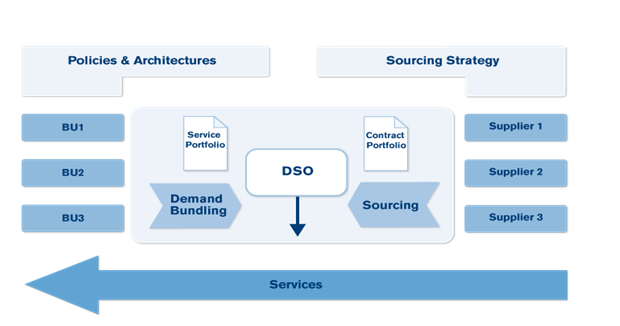IT Governance
Demand Supply Governance (DSG)
Several years ago, the first organizations started taking stock of whether ICT outsourcing had been generating the results initially anticipated. Many organizations came to the realization that outsourcing objectives were not being achieved and that structured attention needed to be paid to managing outsourcing processes. To address these issues, TansTech launched its Demand Supply Governance (DSG) concept in 2001 together with several large Dutch organizations and then went on to develop sourcing governance best practices based on the Sourcing Governance Framework.
In recent years, many organizations have been setting up governance frameworks – discussion as to the point of doing so is no longer the issue. Moreover, in- IT services are also increasingly being managed by the DSG organization. In- supply has thereby become one of the sourcing options. Service managementand supply have been explicitly segregated in to professionalize DSG and to maintain the proper focus. In doing so, the governance organization’s role has been subject to continuous change, shifting from that ofservice provider to governance.
Sourcing governance can essentially be described as follows:
- defining demand for services in consultation with the services’ customers
- translating customer demand into an unambiguous, modularly structured service portfolio within a policy and strategy framework
- developing these services internally and/or externally
- monitoring supplier performance and ensuring that deliverables satisfy customer requirements

The context within which governance is exercised is complex. For example, examining IT developments reveals that IT has evolved from a tool to a strategic factor of production, from an administrative aid to the driving force behind creating competitive advantage and new business models. Add to this the requirements that IT services allow work to be performed in a customer-oriented, flexible and efficient fashion, that they be rapidly deployed and that they be affordable, then it becomes patently evident that DSG is a fully-fledged profession in its own right. Successful governance can be a distinguishing factor between organizations. Successful companies are successful because of governance – or should this read, they are successful atgovernance?
Demand Supply Governance – also termed IT Governance or Sourcing Governance – offers the best of both worlds, i.e. cleverly consolidating business demands and offsetting these against the feasibility and affordability of effective ICT service sourcing. Any organization aiming to take the added value provided by IT to the next level should be seriously considering DSG!
Tangible customer objectives include the following:
- accelerating IT project time-to-market by means of improved set-up and management of business-initiated projects
- clearly improving the effectiveness of in-house and third-party sourcing
- improving management of outsourcing relationships
- reducing operational costs
- tightening the grip on the composition, quality and costs of new and existing services

This approach has been based on our Demand Supply Governance Framework™. Based on COBIT, ITIL®, ASL and BiSL, this framework provides our customers and us a practical benchmark by which to design, implement and manage DSG organizations. The framework includes pre-defined organizational designs, processes, procedures, job descriptions, competency profiles and practical guides.
In addition to our Demand Supply Governance Framework™, we also provide our customers with a governance dashboard that consolidates governance-related KPIs into a single, clearly laid-out management tool for demand and supply management purposes. This dashboard was designed and developed in partnership with Mirror42 and Giarte.
Refer to the side for news, articles, research, case studies and events relating to demand supply governance and management.
Should you have any questions, please do not hesitate to contact us.